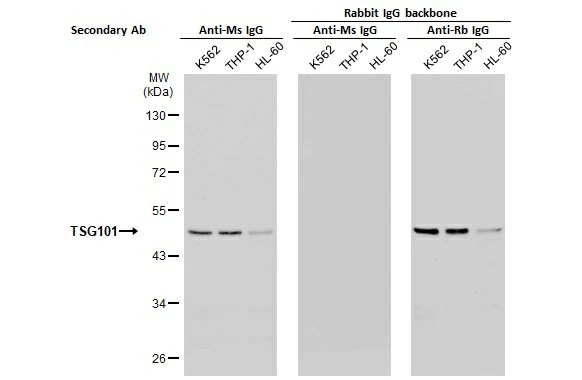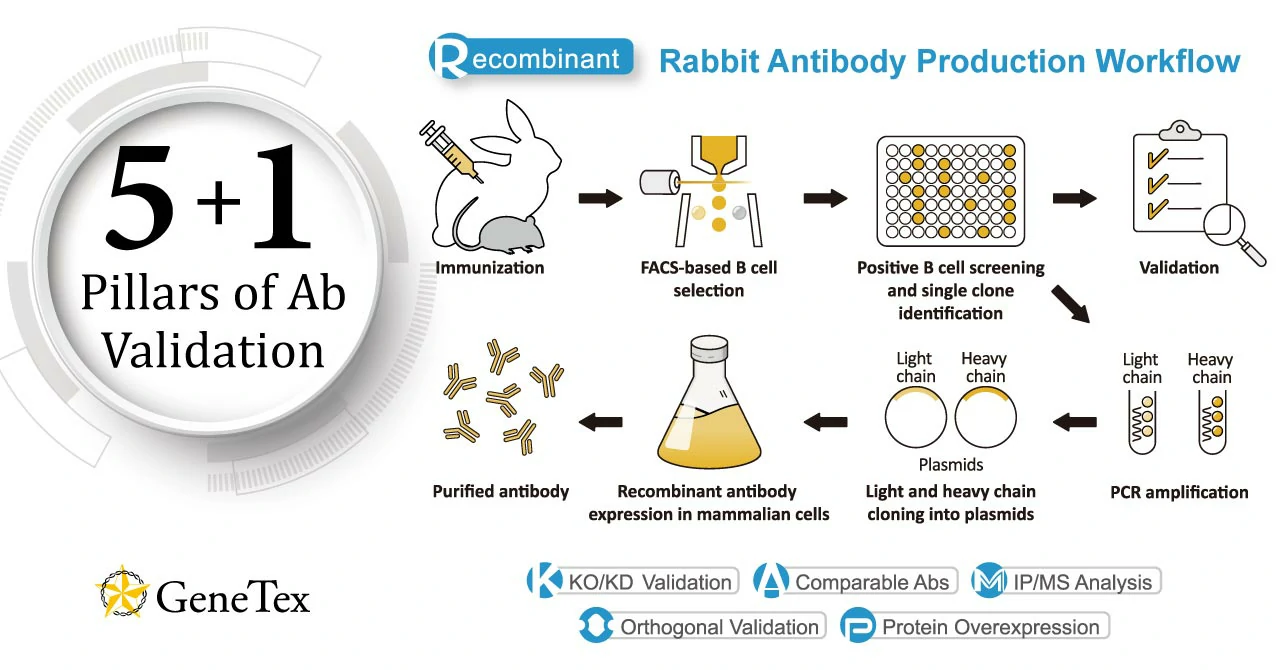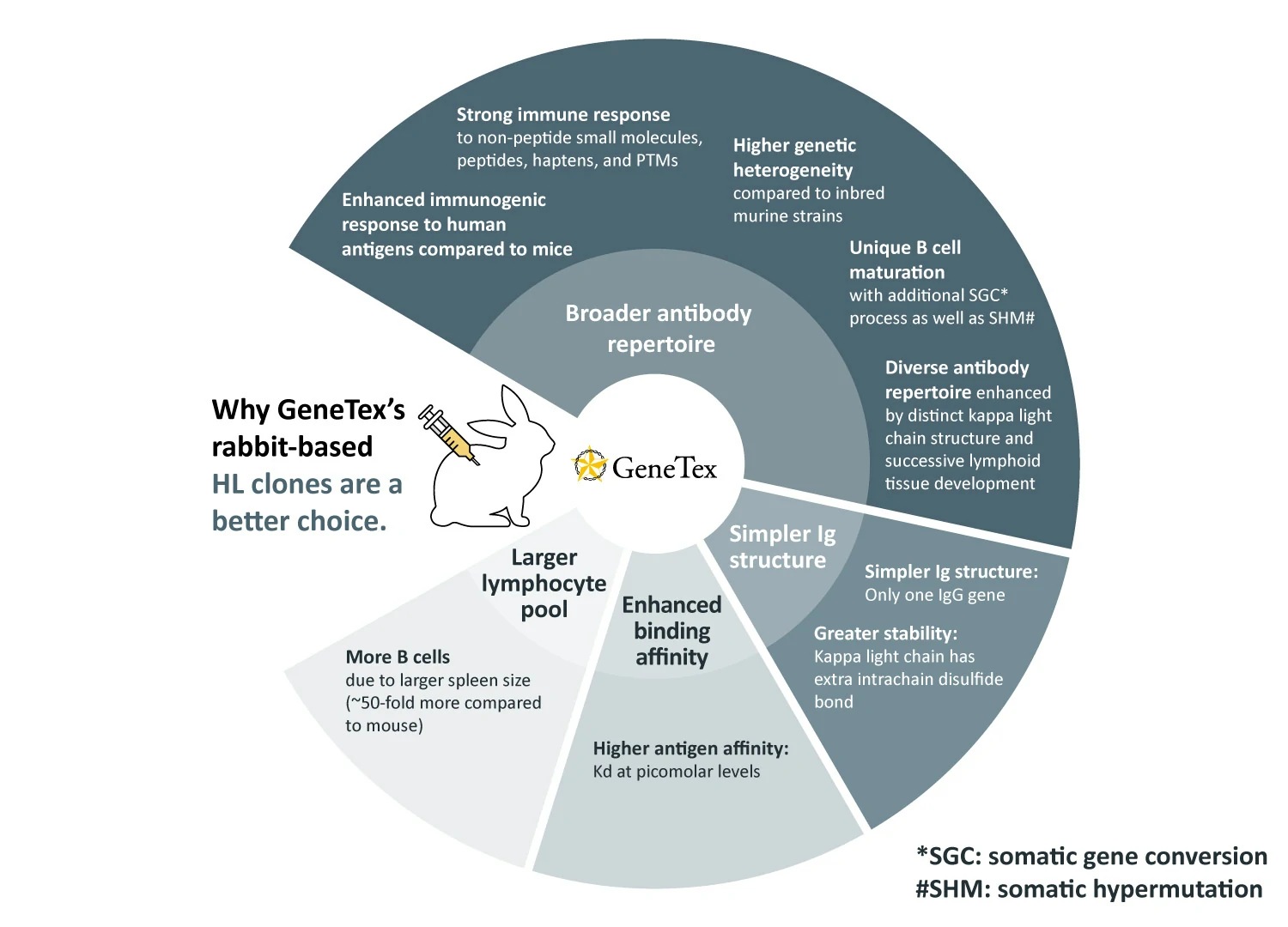重组抗体
 |
|
第 1 节 |
|
第 2 节 |
|
第 3 节 |
为什么 GeneTex 源自于兔子的 HL 克隆是更好的选择
1
第 1 节 什么是重组抗体?
|
重组抗体 (rAb) 是通过传统杂交瘤方法、单独或组合展示策略、从免疫动物中分选单个 B 细胞或通过众多技术任一种方法获得的选定单克隆抗体的克隆、体外表达的重链和轻链产生的,事实上,它是克隆的,这意味着重组抗体是由其一级序列定义的,可以对其进行工程改造以优化亲和力并以不同的结合形式表达,重组抗体的众多优点已得到充分证明,其中性能的一致性至关重要。 GeneTex 的重组抗体生产采用多参数 FACS 为基础的方法,从免疫动物中分离抗原特异性 IgG+ 记忆 B 细胞,随后将抗体可变区基因克隆到 IgG 主链中,并在哺乳动物细胞中表达(图 1) (1),该方法非常快速,可以在几周内完成,并且还提供了鉴别出在各种应用中具有不同功能抗体的机会,重要的是,它是从同一 B 细胞克隆重链和轻链,从而保留自然配对,一旦完成克隆,特定的重组抗体就可以取之不尽用之不竭,并且具有出色的重现性。 |
|
(A) |
 |
| (B) |
 图 1. (A) GeneTex 重组兔单克隆抗体生产流程(Starkie 等人 (2016))。(B)重组抗体的优点。 |
| 如上所述,重组抗体的抗原结合区可以置入各种宿主 IgG 主链或以不同的结合形式(例如 Fab 片段或 scFv)表达。在这里,GeneTex 克隆的TSG101 小鼠单克隆抗体 (GTX70255) 被转换为兔 IgG 主链 (GTX635396),同时保留了性能,当转化的TSG101兔IgG重组抗体与抗小鼠IgG二抗组合使用时,没有观察到交叉反应(图2)。 |

图2. 从克隆小鼠 IgG 抗体将骨干转换为兔 IgG 抗体。 |
参考文献:
第 2 节 GeneTex的重组单克隆抗体生产计划
|
GeneTex 的生产重点是创建新型重组兔单克隆抗体,并使用国际抗体验证工作组 (IWGAV) 定义的严格方法进行验证。 |

图 1. GeneTex 用于重组抗体验证的“5+1”支柱计划 |
|
|
参考文献:
3
第 3 节 为什么 GeneTex 源自于兔子的 HL 克隆是更好的选择
|
GeneTex 的重组兔单克隆抗体生产工艺是全部源自于兔的新型抗体生成的平台 (1),这些产品通过其各自克隆号中的“HL”名称进行区分(例如“[HL1089]”),众所周知,兔子,特别是其免疫系统,可以为产生单克隆抗体带来以下显着优势:更广泛的抗体范围、较不复杂的免疫球蛋白 (Ig) 结构、更高的结合亲和力、更大的淋巴细胞库来选择抗体(图 1)(2),这些优点中的每一个详细地描述在下面:
1. 更广泛的抗体库:
2. 更简单的Ig结构:
3. 增强的结合亲和力:
4. 更大的淋巴细胞池:
|
|
图 1. 用兔子生产单克隆抗体的优势 |
|
GeneTex 希望上述兔单克隆抗体的独特优势能够鼓励您考虑我们的HL 克隆以满足您的研究需求,由于 GeneTex 目前已将其所有新抗体生产转向为兔重组单克隆抗体的生产,因此我们的产品库存将继续快速扩展。 |
参考文献:
- PLoS One. 2016 Mar 29;11(3):e0152282. doi: 10.1371/journal.pone.0152282. eCollection 2016.
- Am J Transl Res. 2011 May 15;3(3):269-74. Epub 2011 Apr 23.
- Comp Immunol.2006;30(1-2):137-53. doi: 10.1016/j.dci.2005.06.017.
- Immunogenetics. 2016 Feb;68(2):83-107. doi: 10.1007/s00251-015-0868-8.
- Exp Mol Med.2017 Mar; 49(3): e305. doi: 10.1038/emm.2017.23.
|
G protein-coupled receptor,GPCRs |
|
|
|
|||||||||||||
|
Cancer Research |
|
|
|
|||||||||||||
|
Neuroscience Research |
|
|
|
|||||||||||||
|
Virus Research |
|
|
|
|||||||||||||
|
Immunology Research |
|
|
|
|||||||||||||
|
Metabolism Research |
|
|
|
|||||||||||||
|
Antibodies for Proteins with Post-translational Modifications |
|
|
|
|||||||||||||
|
Organelle Markers |
|
|
|
|||||||||||||
|
Epitope Tag, Reporter, and Carrier Antibodies |
|
|
|
|||||||||||||



























